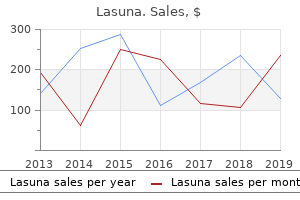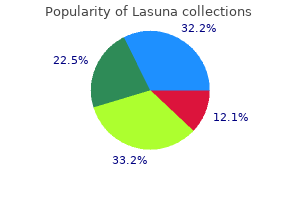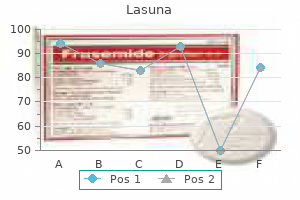"Lasuna 60caps on line, cholesterol quick test."
By: Kate Leslie, MB, BS, MD
- Staff Specialist, Head of Anesthesia Research, Royal Melbourne Hospital
- Professor, Department of Anesthesiology, Monash University, Melbourne, Australia
https://research.monash.edu/en/persons/kate-leslie
Host cells carrying the entry clone are positively selected by the presence of a selectable marker oxidized cholesterol in scrambled eggs lasuna 60 caps with visa. An entry clone is combined with a destination vector that has attR1 and attR2 sites flanking a ccdB gene is a 4.2 cholesterol ratio good discount lasuna 60 caps mastercard. In the presence of integration host factor accutrend cholesterol test strips x 25 generic lasuna 60 caps with mastercard, integrase cholesterol foods high list purchase 60 caps lasuna with visa, and bacteriophage excisionase, the attL1 and attL2 sites on the entry clone recombine with the attR1 and attR2 sites, respectively, on the destination vector. The protein encoded by ccdB is poisonous to remodeled cells with nonrecombined donor vector molecules. The second plasmid, designated a by-product, has the ccdB gene flanked by attP1 and attP2 sites. The strategies for inspecting protein�protein interactions on a large scale require a number of experimental manipulations, with no assure that all potential interactions shall be acknowledged. The two-hybrid methodology that was originally devised for studying the yeast proteome has been used extensively to decide pairwise protein� protein interactions in each eukaryotes and prokaryotes. The underlying precept of this assay is that the bodily connection between two proteins reconstitutes an active transcription factor that initiates the expression of a reporter gene. Often, the Gal4 transcriptional factor from Saccharomyces cerevisiae or the bacterial LexA transcription factor is used. A protein attached to the activation domain is known as the "prey" and doubtlessly interacts with the goal, or bait, protein. In different words, there was a particular interplay between the bait and prey proteins. The product of an active reporter gene could both enable a host cell to proliferate in a particular medium or produce a colorimetric response. A variant of the 2-hybrid system has been developed for studying protein interactions in mammalian cells. Proteins X and Z interact, bringing collectively proteins and, and the exercise specified by the: combination is noticed. The libraries are typically screened for bait�prey protein interactions in certainly one of two ways. In one methodology, a library of yeast cells containing the prey�activation domain constructs is arrayed on a grid. Alternatively, every yeast clone in a bait library is mated en masse with a mix of strains in the prey library, after which positive interactions are identified by screening for activation of the reporter gene. Nonetheless, this strategy has been used to efficiently establish interacting proteins in several organisms, together with bacteria, viruses, yeast, the fruit fly Drosophila melanogaster, the roundworm Caenorhabditis elegans, and people. Specialized computer packages are required to categorize and map all the relationships. As part of this evaluation, stringent statistical criteria are used to decrease the numbers of attainable false-positive interactions in the ultimate knowledge set. In addition, the nuclear, cytoplasmic, and extracellular places of two,268 interactions with 2,346 proteins were mapped. Finally, smaller interacting sets of proteins inside cellular areas were famous. Another examine with Drosophila revealed 710 protein�protein interactions with 641 proteins. The resulting strains in the array that produce bait and prey proteins that interact are detected by assaying for reporter gene activation (activated cells growing in a multiwell plate are indicated in green). The combination of strains is screened for reporter gene exercise, which identifies strains with interacting bait and prey proteins (green). An amino acid sequence tag binds with excessive affinity to a particular molecule and facilitates purification of the goal protein. A "two-tag" system allows two successive rounds of affinity binding to make sure that the goal and its related proteins are free of any nonspecific proteins. The underlying assumption is that the cellular proteins that usually interact with the native protein in vivo may even combine with the tagged protein.

Note nonhomogeneous enhancement in L3 and L4 with lack of involvment of disk space cholesterol reduction medication order 60 caps lasuna otc. Recently cholesterol levels lower naturally generic 60caps lasuna otc, two patients developed fatal coccidioidomycosis after receiving a liver and kidney transplant from a single donor cholesterol 2 eggs a day purchase lasuna 60caps fast delivery. Retrospectively cholesterol foods to lower cheap 60 caps lasuna fast delivery, the donor was discovered to have active coccidioidomycosis with positive coccidioidal serologies and proof of meningitis (Wright et al, 2001). A case of fulminant pulmonary coccidioidomycosis because of transplant of an coccidioidal-contaminated lung has also been observed (Tripathy et al, 2002). These reports counsel that screening of potential organ donors in addition to recipients for proof of active coccidioidomycosis ought to be thought-about previous to organ transplantation. Male sex and growing age, significantly over 60 years, have been associated with increased risk of developing symptomatic coccidioidomycosis, but not necessarily disseminated illness (Arsura, 1997; Ampel et al, 1998; Gray et al, 1998; Leake et al, 2000). Diabetics may have an increased risk of severe pulmonary illness with cavitation (Pappagianis, 1988). Numerous research have discovered that African American males are at markedly increased risk for the event of disseminated coccidioidomycosis when compared to different groups (Flynn et al, 1979; Williams et al, 1979; Ampel et al, 1998; Gray et al, 1998; Rosenstein et al, 2001). For these patients, the medical presentation is commonly stereotypical, with broadly disseminated illness sometimes involving the pores and skin, subcutaneous tissue and vertebrae (See Color. Finally, women who acquire coccidioidomycosis in the course of the second and third trimesters of being pregnant are at increased risk of developing severe, symptomatic, and infrequently disseminated coccidioidomycosis (Wack et al, 1988; Caldwell et al, 2000). Coccidioides grows as a nonpigmented mould often after three to 7 days of incubation at 35�C on a variety of artificial media, together with blood agar. This methodology has a sensitivity and specificity of ninety nine% and 100%, respectively (Stockman et al, 1993). Sputum or different respiratory secretions are regularly culture-positive in primary coccidioidomycosis, cavitary illness, and chronic or persistent pulmonary coccidioidomycosis. When coccidioidomycosis is suspected, cultures of fluid or tissue from involved sites should always be obtained. As previously mentioned, the growth of Coccidioides on artificial media represents a laboratory hazard and suspected samples ought to be handled accordingly (Warnock, 2000). Histopathological identification of spherules is one other methodology for establishing the prognosis of coccidioidomycosis (See Color. In some cases, corresponding to biopsy of pulmonary nodules, identification of spherules appears to have higher sensitivity than culture (Forseth et al, 1986; Chitkara, 1997), while in different cases, corresponding to evaluation of respiratory secretions, discovering of spherules appears to be less delicate (DiTomasso et al, 1994; Sarosi et al, 2001). Serologic tests figuring out anticoccidioidal antibodies had been developed initially and their medical use characterised by Smith and his colleagues nearly 50 years in the past (Smith et al, 1956). They remain essential today both in the prognosis and the administration of coccidioidomycosis (Pappagianis and Zimmer, 1990; Pappagianis, 2001). Because of modifications in nomenclature and methodology, coccidioidal serologic tests can be confusing. A easy means of contemplating coccidioidal serology is to divide serologic tests into detection of IgM or IgG antibodies. IgG antibody can be detected by the flexibility of serum to repair complement when mixed with coccidioidal antigen. IgG antibodies are detected later than IgM antibodies but persist in these with continued active illness. Amphotericin B, formulated with deoxycholate, has been used for the administration of severe coccidioidomycosis for nearly 50 years (Winn, 1959). While no formal examine has ever been done, review of published instances suggests that intravenous amphotericin B induces medical improvement in as much as 70% of patients handled (Hardenbrook and Barriere, 1982). Unfortunately, the properly-known opposed occasions of amphotericin B have restricted its usefulness. In addition, intravenous amphotericin is ineffective in coccidioidal meningitis, and intrathecal remedy is required. Because of those issues, using amphotericin B for the administration of coccidioidomycosis has generally been supplanted by the oral azole antifungal medicine. However, many clinicians still choose intravenous amphotericin B as initial remedy for severely sick patients. In addition, some patients would require amphotericin B if they fail to respond to azole antifungal medicine.

However cholesterol ratio uk cheap lasuna 60 caps online, the ease with which a fungal pathogen may be acknowledged in tissue depends not solely on its abundance cholesterol levels chart canada lasuna 60 caps visa, but in addition on the distinctiveness of its look cholesterol levels and what they mean best 60caps lasuna. Many fungi stain poorly with hematoxylin and eosin and this methodology alone may be inadequate to cholesterol test cost in hyderabad generic lasuna 60 caps otc reveal fungal components in tissue. There are a variety of particular stains for detecting and highlighting fungal organisms and the clinician should request these if a mycotic disease is suspected. Methenamine-silver (Grocott or Gomori) and periodic acid-Schiff staining are among the most generally used procedures for specific staining of the fungal cell wall. It should be appreciated that these staining strategies, although useful at revealing the presence of fungal components in tissue, seldom allow the precise fungal genus involved to be identified. Likewise, the detection of small, budding fungal cells seldom permits a selected diagnosis. To overcome this problem, a variety of strategies have been developed on a analysis basis for figuring out various fungal organisms specifically Laboratory elements of medical mycology 7 in tissue. Immunoperoxidase and immunofluorescent staining reagents, both monoclonal and polyclonal, can be found for some fungal agents (Arrese-Estrada et al, 1990; Kaufman et al, 1997). Immunochemical staining can facilitate the identification of atypical fungal components and the detection of small numbers of organisms. For example, an IgG1 monoclonal antibody 3H8 has been described that specifically recognizes Candida albicans in tissue sections utilizing either immunofluorescent or immunohistochemical staining formats (Marcilla et al, 1999). However, development on these media may be sluggish and improvement of the spores and other constructions utilized in fungal identification may be poor. For these causes, most laboratories use a number of totally different tradition media and incubation situations for recovery of fungal agents. However, a variety of extra incubation situations and media may be required for development of particular organisms in tradition. The laboratory should be made conscious of the actual fungal agent(s) that are suspected in a given pattern in order that the most applicable media may be included. The medically necessary Candida species appear as totally different coloured colonies as a result of differential uptake of those chromogenic compounds. However, gentamicin, vancomycin, and other antimicrobial agents are more and more being used to suppress development of micro organism immune to older agents. If dermatophytes or dimorphic fungi are being isolated, cycloheximide (actidione) should be added to the medium, to prevent overgrowth by faster-rising fungi. Material from subcutaneous or deep websites should be incubated at two temperatures, 25�C�30�C and 37�C, as a result of a variety of necessary pathogens, including H. Many pathogenic fungi develop slowly in tradition and require plates to be held for up to 4 weeks, before being discarded as negative. Cultures should be examined at frequent intervals (at least three times weekly) and applicable subcultures made, particularly from blood-enriched media on which fungi often fail to sporulate. In these circumstances, tradition results should be compared with these of microscopic examination. Isolation of opportunistic fungal pathogens from sterile websites, similar to blood or cerebrospinal fluid, often provides reliable evidence of deep-seated an infection, however their isolation from material similar to pus, sputum or urine must be interpreted with care. Attention should be paid to the quantity of fungus isolated and additional investigations undertaken. Many unfamiliar moulds have been reported as occasional causes of lethal systemic an infection in immunocompromised patients. No isolate should be dismissed as a contaminant without cautious consideration of the medical condition of the affected person, the site of isolation, the method of specimen collection, and the probability of contamination. In one other recent report, solely 245 of 1209 isolates of Aspergillus species collected from hospitalized patients represented circumstances of medical aspergillosis (Perfect et al, 2001). Although tradition often permits the definitive diagnosis of a fungal an infection, it has some necessary limitations. Incorrect isolation procedures and inadequate durations of incubation are other necessary factors. Blood Culture In general, Candida species are more readily recovered from blood than are dimorphic fungi and moulds. Isolation rates are higher when the medium is vented and aerated, and biphasic media incorporating both agar and broth phases are simpler than broth. The possibilities of profitable isolation are increased if a number of samples of blood are collected, and larger volumes are cultured.

Ciprofloxacin is accredited for use in urinary tract infections; lower respiratory infections; sinusitis; bone quick cholesterol lowering foods generic lasuna 60caps mastercard, joint cholesterol zelf test buy 60caps lasuna, and skin structure infections; empiric use in febrile neutropenic sufferers; typhoid fever; urethral and cervical gonococcal infections; and infectious diarrhea cholesterol range age chart order 60caps lasuna otc. Ofloxacin is accredited for use in lower respiratory infections cholesterol test monitor buy generic lasuna 60 caps on line, uncomplicated gonococcal and chlamydial cervicitis and urethritis, skin and skin structure infections, prostatitis, and urinary tract infections. Gemifloxacin, moxifloxacin, and levofloxacin are also utilized in lower respiratory tract infections. Infrequent opposed results embody rash, urticaria, leukopenia, and elevated liver enzymes. Variable results on theophylline ranges have been reported from different members of the group. Antacids and sucralfate and divalent or trivalent cations such as iron significantly decrease the absorption of fluoroquinolones. Some fluoroquinolones have been reported to improve the consequences of oral anticoagulants. Hyperglycemia and hypoglycemia have been reported in sufferers receiving quinolones and an antidiabetic agent. Methenamine is hydrolyzed to ammonia and formaldehyde in acidic urine; formaldehyde is antibacterial against gram-positive and gram-unfavorable organisms. Mandelic and hippuric acids, with which methenamine is mixed, present supplementary antibacterial action. The bactericidal action is due to its inactivation of the enzyme enolpyruvyl transferase, thereby blocking the condensation of uridine diphosphate-N-acetylglucosamine with p-enolpyruvate, one of the first steps in bacterial cell wall synthesis. Nitrofurantoin is lively against many gram-positive and gram-unfavorable organisms, together with some strains of E. Methenamine and nitrofurantoin are used to prevent and treat urinary tract infections. Quinolones are administered to treat urinary tract infections; some also are utilized in such diseases as osteomyelitis and respiratory tract infections. Fosfomycin is indicated for therapy of uncomplicated urinary tract infection (acute cystitis) in ladies caused by vulnerable strains of E. Methenamine may trigger nausea, vomiting, and diarrhea; in high doses, it could result in urinary tract irritation. The results of methenamine are inhibited by alkalinizing agents and are antagonized by acetazolamide. Nitrofurantoin blood ranges are increased and urine ranges decreased by sulfinpyrazone and probenecid, leading to increased toxicity and decreased therapeutic effectiveness. Quinolones (1) Cinoxacin urine ranges are decreased by probenecid, reducing therapeutic effectiveness. This agent was the first commercially out there monobactam (monocyclic -lactam compound). This drug is lively against many gram-unfavorable organisms, together with Enterobacter and some strains of P. Aztreonam is therapeutic for urinary tract infections, septicemia, skin infections, lower respiratory tract infections, and intra-belly infections resulting from gram-unfavorable organisms. Precautions and monitoring results (1) Aztreonam sometimes causes nausea, vomiting, and diarrhea. A nitrobenzene spinoff, this drug has broad exercise against rickettsia as well as many gram-positive and gram-unfavorable organisms. Chloramphenicol is primarily bacteriostatic, although it could be bactericidal against a number of bacterial strains. This agent is lively against rickettsia and a wide range of bacteria, together with H. Such infections typically embody (1) Typhoid fever (2) Meningococcal infections in cephalosporin-allergic sufferers (three) Serious H. Precautions and monitoring results (1) Chloramphenicol may cause bone marrow suppression (dose-associated) with resulting pancytopenia; rarely, the drug results in aplastic anemia (not associated to dose). This harmful response, which stems partly from inadequate liver cleansing of the drug, is manifested by vomiting, grey cyanosis, fast and irregular respirations, vasomotor collapse, and in some instances death.
Discount lasuna 60caps fast delivery. How To Lower Your Cholesterol With Diet & Foods? - by Dr Sam Robbins.
References:
- http://preventcrypto.org/wp-content/uploads/2012/07/Rwanda-National-Comprehensive-HIV-STD-Guidelines-2013.pdf
- https://cmr.asm.org/content/cmr/33/3/e00035-19.full.pdf
- https://www.unmc.edu/intmed/divisions/id/asp/clinical-pathways/docs/DFI_institutional_guideline_final.pdf
- http://www.cfsph.iastate.edu/Factsheets/pdfs/giardiasis.pdf

